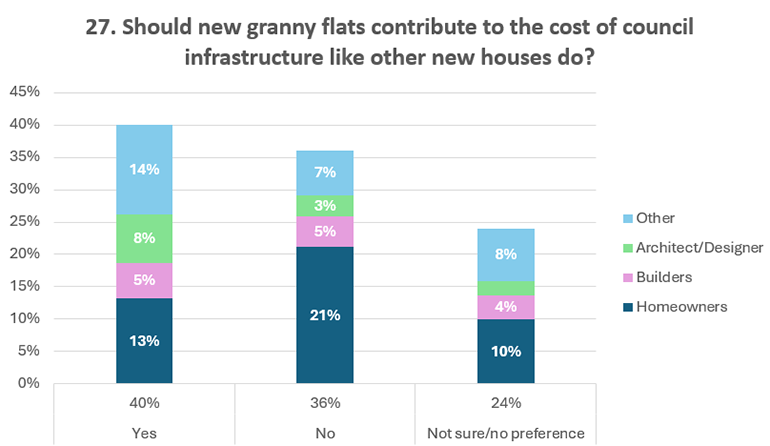Question 27
On this page
What was asked
Question 27: Should new granny flats contribute to the cost of council infrastructure like other new houses do?
Summary of feedback
Overall, 1450 submissions were received on this question, featuring 580 submitting that granny flats should contribute to the cost of council infrastructure, 522 that they should not, and 348 who were either unsure or had no preference on the matter.
Figure 16: Graph detailing the response to question 27

Text description for graph - Figure 16: Graph detailing the response to question 27
Submitters were also given the opportunity to explain their views, 799 submissions provided this further explanation.
Most responses to this question focused on the suitability and competency of the authorised tradespeople named in the proposal, rather than on the occupational licensing regimes themselves.
There was little comment on the occupational licensing regime for authorised plumbers. Where submissions were made on plumbers, concerns were raised around the potential inconsistency that the proposal may create if plumbing work can be completed without a consent in the context of a granny flat, but not outside of it.
The most common concern raised was a mistrust of Licensed Building Practitioners. Submitters stated that under the existing system Licensed Building Practitioners rely on the building consent system and building inspections as a quality assurance check, and that without it, there is significant risk of non-compliance.
Homeowners
Most homeowners were not in favour of contributions for council infrastructure. Many submissions suggested that the notion defeats the purpose of the proposal and that households already contribute substantially to local infrastructure development. A number of submissions suggested that the proposal would be a ‘money grab’ by councils. Some submissions pointed out that housing family members already living on the property in a separate dwelling on the property, as may often be the case with a granny flat, should constitute no additional resource demand on council infrastructure.
However, a few homeowner submissions were in favour of the proposal, mostly noting that the dwellings would place burden on local infrastructure, and that proportionate contributions from smaller dwellings would be warranted. Many of these submissions proposed that contributions from smaller dwellings should be capped to a certain threshold.
Iwi, hapū and Māori
Only a couple of submissions were received from iwi, hapū and Māori on this question. Most expressed views similar to other groups – that small dwellings would add to council infrastructure demand and should contribute proportionately. The alternative view was that council rates should include provision for infrastructure demand through changes to the rateable value of a property through the addition of a small dwelling.
Councils
The large majority of council submissions were in favour of the proposal, for reasons also cited by other groups. Of the few submissions not in favour, most were opposed to the proposals for enabling granny flats generally, while a few noted that, for rural zones as opposed to residential zones, a granny flat would not be using council infrastructure and therefore shouldn’t need to contribute to costs.
Industry
Industry feedback was mixed among different trade groups. Builder sentiment was evenly split both for and against the proposal, with a high proportion of unsure or no preference stated. Most of the industry groups were generally in favour of the proposal, with submissions from architects and designers representing the highest proportion of responses in favour of the proposal. Feedback generally pointed out that small dwellings would add to the load on local infrastructure demand, but that costs on owners should be proportionate. Some responses suggested that contributions should depend on whether the addition of a dwelling on a property would require new connections, or if it would connect to the main house.

